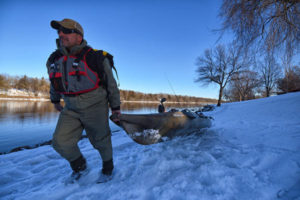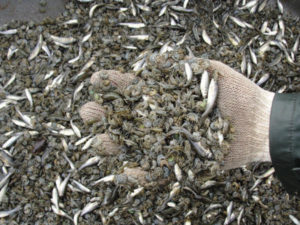Michigan Technology Enhances DNRs Ability to Gather, Share Natural Resources Information
By BOB GWIZDZ
Michigan Department of Natural Resources
from The Fishing Wire
With an electric current pulsing through the waters of a secluded stream, brook trout and other fish swirl into view – stunned briefly – before they are captured, measured, counted and released.
The information gathered from these sampling efforts helps fisheries biologists assess stream fish populations.
Meanwhile, the use of electroshocking is one example of how the Michigan Department of Natural Resources employs technology to help produce, retrieve or collect valuable data on a wide range of subjects.
Technology is defined as the application of scientific knowledge for practical purposes. From that perspective, the DNR has always been a high-tech agency.
But as technology advances, the DNR continues to adopt new concepts and techniques as it carries out its task of managing the state’s natural resources.
Some technological applications are explicit to the DNR’s various divisions, like those specialized for managing forests, fish or wildlife. Others are wide-ranging and involve the entire department.
Geographical Information Systems (GIS) technology, for example, is used across the DNR. GIS uses maps and aerial photography to display various layers of data, from political boundaries like county lines to forest types, locations of campgrounds or other information.
Maps can be created with GIS displaying specific layers of data the user is interested in, while omitting others.
“It’s all about data,” explained David Forstat, who runs the DNR’s Resource Assessment Section (RAS). “We work with all divisions within the department.”
The Resource Assessment Section has 20 employees. Most of these workers are headquartered in Lansing, but several employees are situated in the northern Lower Peninsula with plans to add a person in the Upper Peninsula.
“We use the data to answer questions,” Forstat said. “We know where the deer are, where the wolves are, we keep track of the trees – we have tools to go out in the woods and map where the trees are.
“We know how old the trees are, we know where we have diseased trees and healthy trees, which trees need to be cut, whether they’re a certain age or a certain size. We know where young trees are that need to be thinned out.”
Forstat said the DNR’s Forest Resources Division supplies 50 percent of the RAS budget and is its biggest beneficiary.
“If a chip board company wants to come into Michigan, they need to know where the trees are, a certain age of trees, a certain size of tree, a certain kind of tree,” Forstat said. “They want to know about the transportation system, where there’s a big highway or railroad so they can haul the lumber in, process it and ship it out. They may need to know they have a source of electricity or water.”
Michigan has been working on GIS since the late 1970s, but the data collection just continues to get more sophisticated.
“We’ve got 1,000-plus different data layers,” Forstat said. “We’ve been flying the state every year or every other year to get high-resolution aerial imagery.”
Forstat points to a popular DNR program – Mi-HUNT – as an example of how the DNR’s Wildlife Division provides information to hunters across the nation from data provided by the Resource Assessment Section.
The online mapping application directs hunters to the nearly 10 million acres of land open to public hunting in the state.
Wildlife biologist Mike Donovan, who heads up Mi-HUNT, said hunters can find all the places – state game areas, state and national forest land, state park land open to hunting, even private land available to hunters through the Commercial Forest Act or Hunter Access Program – they can go for their next hunt.
“It’s an interactive map that shows you where the land is and provides aerial photos – leaf-on and leaf-off – topographical maps and vegetative cover types,” Donovan said. “It’ll tell you the size density and the age of the trees.
“And it’s really the best place to go for HAP information because that stuff can change so quickly.”
The public has access to all the RAS data.
“People who recreate outdoors are probably our biggest users,” Forstat said. “Most DNR field staff use GIS, but the public – people who use trails or camp or hunt – use it more than our folks.
“We even have an app to find morels, to look for a place where we had a forest fire or a controlled burn, because morels like to grow where there’s been a fire.”
Forstat said the DNR uses GIS data in its conservation officer vehicles, on its boats when collecting fisheries data and in state forests in a variety of ways.
“When you have things that come up quickly, like a forest fire, you want all that data at your fingertips,” he said.
The DNR is also using geographic data to keep track of the state’s cultural resources.
“The Resource Assessment Section is working on a project for the Michigan History Center to assist with cataloguing all the historical markers with GPS coordinates,” Forstat said. “And we developed an application that can be used on smart phone devices. Staffers used the application to verify marker locations, condition, and for the collection of photographs of the markers around the state.”
Now travelers and others interested in Michigan history can easily find historical markers with a quick search at www.michigan.gov/markers.
Forstat, who studied geology, began his DNR career inspecting oil and gas wells.
“You had to take all of your books, all of your maps out there with you. I figured there had to be an easier way to capture the locations of all the wells in the state, their conditions and any pollution problems associated with them,” he said.
DNR staffers developed a program to track them from the office.
“After that, GIS just exploded,” he said. “Computers were the way to go.”
Forstat said that the big push to digitize this data came in the 1980s, when the DNR converted paper maps to digital maps.
“I remember we had one computer and you had to sign up to use it,” Forstat said. “Now we have more data on our cell phones than we had on that computer.”
Gary Whelan, the DNR Fisheries Division’s program manager for research and fish health, said acoustic tags – transmitters implanted in the body cavities of the fish – are giving fisheries managers access to information that seemed like science fiction just a few short years ago.
The DNR has set up a series of dozens of receivers that pick up the tags’ signals.
“We have them in walleye, sturgeon, whitefish – anything we want to know when and where the fish are using habitats – what spawning habitat, which prey resources they’re using,” Whelan said.
“An example is Saginaw Bay walleye – we can find out when a fish leaves the inner bay and we have receivers all the way up Lake Huron and all the way to the bridge. They produce an ungodly amount of data.”
Another fish-tagging program involves using pop-up tags, that attach to a specimen’s back and eventually release, to record temperature and depth data. The tags send a signal to a satellite, so fisheries researchers can locate and recover them.
“It tells us a lot about what habitat the fish are using day by day,” Whelan said.
Other high-tech fisheries projects involve using remotely operated vehicles, towed by fisheries research vessels, that can carry video cameras, hydro-acoustic units to estimate prey abundance and water-quality monitors.
“We’re using a lot of GoPro cameras too,” Whelan said. “We use them to count gobies – drop a GoPro on a tripod on a reef, for instance – and we’re using GoPros on our research nets, to see how they’re fishing and whether fish are avoiding them.”
The DNR has been using modern communications media, such as Facebook and YouTube, to communicate to the public for years. But it’s also developing communication tools for department’s website that give the public more information than ever before.
Eric Hilliard, a digital media and web resources specialist with the DNR’s Wildlife Division for the last five years, has recently completed an online waterfowl count “dashboard” that shows hunters how many and which species are using the state’s managed waterfowl areas. It’s available at www.michigan.gov/wetlandwonders.
“Last year it had 30,000 views,” Hilliard said.
Even the technology used to collect that sort of information has changed.
David Luukkonen, a wildlife research biologist, said that DNR staffers who fly over the state to survey waterfowl have always made notes as they flew. Now they use voice recorders with an app that applies a GPS pin as it records, so the DNR knows exactly where the birds are.
This is coming in especially handy, Luukkonen said, as the DNR is conducting a survey of diving ducks and other pelagic (open-water) birds. As energy companies push to build off-shore wind facilities, the DNR data will show which areas of the lakes the birds use to help avoid conflicts.
Meanwhile, Luukkonen is working with a graduate student at Michigan State University on a mute swan study. Forty-five GPS-collared swans transmit data to cellular towers whenever they are within range of a tower, which is practically all the time.
“The idea is to develop a population model of mute swans, so we can effectively manage them,” Luukkonen said. “We’re finding out all kinds of things about them we didn’t know. We thought they were fairly residential birds, but we’ve found that they travel a lot more than we knew. And we’ve even found them feeding in fields, something we never suspected.”
As technology continues to advance, one thing is clear – improving the DNR’s ability to collect and share information benefits both Michigan’s natural resources and the people who enjoy them.
Check out previous Showcasing the DNR stories and subscribe to upcoming articles at www.michigan.gov/dnrstories.

